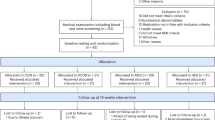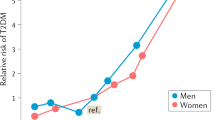Abstract
OBJECTIVE: Sibutramine favors a negative energy balance and also has the potential to increase heart rate and blood pressure. We investigated if a progressive supervised sibutramine–diet–exercise clinical intervention could increase the body weight loss previously reported while minimizing the potential cardiostimulatory effects of this drug.
DESIGN AND SUBJECTS: The tri-therapy intervention was divided into two phases of 6 weeks each in which sibutramine (10 mg) was taken once daily by eight obese men (body mass index (BMI) between 30 and 40 kg/m2). Part A consisted of a dietary follow-up with an energy restriction, whereas in part B an aerobic exercise program combined with a low-fat diet was introduced. Systolic (SBP) and diastolic (DBP) blood pressure, resting heart rate (RHR) and body weight were measured every 2 weeks while body density, resting metabolic rate (RMR) and respiratory quotient (RQ) were determined before and after the intervention.
RESULTS: This clinical intervention produced a substantial body weight loss (−10.7 kg, P<0.01) which was about twice as much as other 12-week studies. In part A, both RHR (+4 beats/min) and DBP (+5 mmHg, P<0.01) were increased. However, after part B, RHR (−8 beats/min, P=0.02) and DBP (−3 mmHg, P<0.01) were significantly decreased. RMR was decreased at the end of the program but this effect did not persist after adjustments for fat-free mass. RQ was also reduced (−0.05, P<0.01) following the clinical tri-therapy.
CONCLUSION: In conclusion, these observations suggest that this clinical tri-therapy favored a satisfactory benefit–risk profile since it enhanced weight loss without inducing increases in heart rate and blood pressure or detrimental changes in RMR and substrate oxidation.
This is a preview of subscription content, access via your institution
Access options
Subscribe to this journal
Receive 12 print issues and online access
$259.00 per year
only $21.58 per issue
Buy this article
- Purchase on Springer Link
- Instant access to full article PDF
Prices may be subject to local taxes which are calculated during checkout

Similar content being viewed by others
References
Apfelbaum M, Vague P, Ziegler O, Hanotin C, Thomas F, Leutenegger E . Long-term maintenance of weight loss after a very-low-calorie diet: efficacy and tolerability of sibutramine vs placebo Am J Med 1999 106: 179–184.
Hanotin C, Thomas F, Jones SP, Leutenegger E, Drouin P . Efficacy and tolerability of sibutramine in obese patients: a dose-ranging study Int J Obes Relat Metab Disord 1998 22: 32–38.
Bray GA, Blackburn GL, Ferguson JM, Greenway FL, Jain AK, Mendel CM, Mendels J, Ryan DH, Schwartz SL, Scheinbaum ML, Seaton TB . Sibutramine produces dose-related weight loss Obes Res 1999 7: 189–198.
Seagle HM, Bessen DH, Hill JO . Effects of sibutramine on resting metabolic rate and weight loss in overweight women Obes Res 1998 6: 115–121.
Kelly F, Wade AG, Jones SP, Johnson SG . Sibutramine hydrochloride vs dexenfluramine: weight loss in obese subjects Int J Obes Relat Metab Disord 1994 18: 61 (0235).
Connoley IP, Heal DJ, Stock MJ . A study in rats on the effects of sibutramine on food intake and thermogenesis Br J Pharmac 1995 114: 388.
Connoley IP, Frost I, Heal DJ, Stock MJ . Role of b-adrenoreceptors in mediating thermogenic effects of sibutramine Br J Pharmac 1996 117: 170.
Walsh KM, Leen E, Lean MEJ . The effect of sibutramine on resting energy expenditure and adrenaline-induced thermogenesis in obese females Int J Obes Relat Metab Disord 1999 23: 1009–1015.
Rolls BJ, Shide DJ, Thorwart ML, Ulbrecht JS . Sibutramine reduces food intake in non-dieting women with obesity Obes Res 1998 6: 1–11.
Hansen DL, Toubro S, Stock MJ, Macdonald IA, Astrup A . The effect of sibutramine on energy expenditure and appetite during chronic treatment without dietary restriction Int J Obes Relat Metab Disord 1999 23: 1016–1024.
Buckett WR, Thomas PC, Luscombe GP . The pharmacology of sibutramine hydrochloride (BTS 54524), a new anti-depressant which induces rapid noradrenergic down-regulation Prog Neuropsychopharm Biol Psychol 1988 12: 575–584.
Gundlah C, Martin KF, Heal DJ, Auerbach SB . In vivo criteria to differentiate monoamine reuptake inhibitors from releasing agents: sibutramine is a reuptake inhibitor J Pharm Ther 1997 288: 581–591.
Bray GA, Ryan DH, Gordon D, Heidingsfelder S, Cerise F, Wilson K . A double-blind randomized placebo-controlled trial of sibutramine Obes Res 1996 4: 263–270.
Despres JP, Lamarche B . Effects of diet and physical activity on adiposity and body fat distribution: implication for the prevention of cardiovascular disease Nutr Res Rev 1993 6: 137–159.
Goldstein DJ . Beneficial health effects of modest weight loss Int J Obes Relat Metab Disord 1992 16: 397–415.
Buemann B, Astrup A, Madsen J, Christensen NJ . A 24-h energy expenditure study on reduced-obese and nonobese women: effect of B-blockade Am J Clin Nutr 1992 56: 662–670.
Doucet E, St-Pierre S, Alméras N, Mauriège P, Richard D, Tremblay A . Changes in energy expenditure and substrate oxidation resulting from weight loss in obese men and women: is there an important contribution of leptin? J Clin Endocrinol Metab 2000 8: 1–7.
Larson DE, Ferrano RT, Robertson DS, Ravussin E . Energy metabolism in weight-stable post obese individuals Am J Clin Nutr 1995 62: 735–739.
Field CJGR, Marliss EB . Changes in circulating leucocytes and mitogen responses during very-low-energy all-protein reducing diets Am J Clin Nutr 1991 54: 123–129.
Nieman DC, Nehlsen-Cannarella SL, Henson DA, Butterworth DE, Fagoaga OR, Warren BJ, Rainwater MK . Immune response to obesity and moderate weight loss Int J Obes Relat Metab Disord 1996 20: 353–360.
Stallone DD . The influence of obesity and its treatment on the immune system Nutr Rev 1994 52: 37–50.
Burton BT, Foster WR . Health implications of obesity: an NIH consensus development conference J Am Diet Assoc 1985 85: 1117–1121.
Tremblay A, Doucet E . Obesity: a disease or a biological adaptation? Obes Rev 2000 1: 27–35.
White MD, Bouchard G, Bueman B, Alméras N, Després JP, Bouchard C, Tremblay A . Energy and macronutrient balances for humans in a whole body metabolic chamber without control of preceeding diet and activity level Int J Obes Relat Metab Disord 1997 21: 135–140.
The Canadian Nutrient File . Health and Welfare Canada 1991.
Lohman TG, Roche AF, Martorerell R . Skinfold thicknesses and measurement technique. In: Lohham TGRA, Martello R (eds). Anthropometric standardization reference manual Human Kinetics Champaign, IL 1988 53–80.
Behnke AR, Wilmore JH . Evaluation and regulation of body build and composition Prentice-Hall: Englewood Cliffs, NJ 1974 20–37.
Meneely EA, Kaltreider NL . Volume of the lung determined by helium dilution J Clin Invest 1949 28: 129–139.
Siri WE . The gross composition of the body Adv Biol Med Physiol 1956 4: 238–280.
Weir JB . New method for calculating metabolic rate with special references to protein metabolism J Physiol (Lond) 1949 109: 1–9.
Laboratories R . Body-composition assessments in youth and adults In: Roche E Jr (ed.) Report of the Sixth ROSS Conference on medical Research Ross Laboratories: Colombus, OH 1985 11.
Richterich R, Dauwwalder H . Zur bestimmung der plasma-glukose-konzentration mit der hexokinase-glucose-6-phosphat-deshydrogenase-methode Schweiz Med WochenschrSchweiz Med Wochenschr 1971 101: 615–618.
Moorjani S, Gagné C, Lupien PJ, Brun D . Plasma triglycerides related decrease in high density lipoprotein cholesterol and its association with myocardial infarction in heterozygous familial hypercholesterolemia Metabolism 1986 35: 311–316.
Hanotin C, Thomas F, Jones SP, Leutenegger E, Drouin P . A comparison of sibutramine and dexfenfluramine in the treatment of obesity Obes Res 1998 6: 285–291.
Doucet E, Imbeault P, Alméras N, Tremblay A . Physical activity and low-fat diet: is it enough to maintain weight stability in the reduced-obese individual following weight loss by drug therapy and energy restriction? Obes Res 1999 7: 323–333.
Ravussin E, Lillioja S, Knowler WC, Christin L, Freymond D, Abbott WGH, Boyce V, Howard BV, Bogardus C . Reduced rate of energy expenditure as a risk factor for body-weight gain New Engl J Med 1988 8: 467–472.
Zurlo F, Lillioja S, Esposito Del Puente A, Raz I, Saad MF, Swinburn BA, Knowler WC, Bogardus C, Ravussin E . Low ratio of fat to carbohydrate oxidation as predictor of weight gain: study of 24h-RQ Am J Physiol 1990 259: E650–E657.
Leibel RL, Rosenbaum M, Hirsch J . Changes in energy expenditure resulting from altered body weight New Engl J Med 1995 332: 621–628.
Henriksson J . Effects of physical training on the metabolism of skeletal muscle Diabetes Care 1992 15: 1707–1711.
Scanga CB, Verde TJ, Paolone AM, Anderson RE, Wadden TA . Effects of weight loss and exercise training on natural killer cell activity in obese women Med Sci Sports Exerc 1998 30: 1666–1671.
Kelley DS, Daudu PA, Branch LB, Johson HL, Taylor PC, Mackey B . Energy restriction decreases number of circulating natural killer cells and serum levels of immunoglobulins in overweight women Eur J Clin Nutr 1994 48: 9–18.
Stallone DD, Stunkard AJ, Zweiman B, Wadden TA, Foster GD . Decline in delayed-type hypersensitivity response in obese women following weight reduction Clin Diagn Lab Immunol 1994 1: 202–205.
Mc Ardle WD, Katch FI, Katch VL . Functional capacity of the cardiovascular system. In: Balado D (ed). Exercise physiology 4th edn, chap 17. William and Wilkins: Baltimore, MD 1996 296–312.
Seals DR, Hagberg JM . The effect of exercise training on human hypertension Med Sci Sports Exerc 1984 16: 207–215.
Plourde C, Rousseau-Migeron S, Nadeau A . B-adrenoreceptor adenylate cyclase system adaptation to physical training in rat ventricular tissue J Appl Physiol 1991 70: 1633–1638.
Acknowledgements
This research was supported by a grant from Knoll Pharma Company. We wish to thank Yanick Angers and Patrick Dufour who were responsible for the prescription and supervision of the exercise program.
Author information
Authors and Affiliations
Corresponding author
Appendix
Appendix
Rights and permissions
About this article
Cite this article
Bérubé-Parent, S., Prud'homme, D., St-Pierre, S. et al. Obesity treatment with a progressive clinical tri-therapy combining sibutramine and a supervised diet–exercise intervention. Int J Obes 25, 1144–1153 (2001). https://doi.org/10.1038/sj.ijo.0801677
Received:
Revised:
Accepted:
Published:
Issue Date:
DOI: https://doi.org/10.1038/sj.ijo.0801677
Keywords
This article is cited by
-
Irisin is more strongly predicted by muscle oxidative potential than adiposity in non-diabetic men
Journal of Physiology and Biochemistry (2015)
-
Does it matter how we lower blood pressure in obese hypertensive patients?
Current Hypertension Reports (2008)
-
Changes in fat-free mass during significant weight loss: a systematic review
International Journal of Obesity (2007)
-
Current and novel approaches to the drug therapy of obesity
European Journal of Clinical Pharmacology (2006)
-
Sibutramine and the sympathetic nervous system in obese humans
Clinical Autonomic Research (2005)



